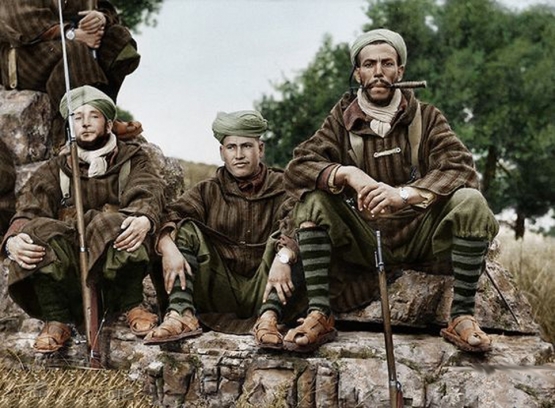-
Posts
3,296 -
Joined
-
Days Won
1
Posts posted by Wicky
-
-
1 hour ago, Chudacabra said:
Yes, I've tried adding it with the same file name and a changed file name.
Have you scrolled through the scenario listing pages using the 'Next' button?
-
12 minutes ago, Chudacabra said:
Has anyone else had difficulty getting this to show up in the battle list? I can see the .btt file in the correct folder, but it doesn't show up in game.

-
Seems you've found a gamey loophole...
-
Best open a support ticket
-
Too subversive - we got Top Cat instead
edit. The series was renamed for British audiences to Boss Cat because there was a cat food called Top Cat on sale in the UK.
-
13 minutes ago, John Kettler said:
Who's Pike?

-
Chunky zips à la mode...

-
On 12/9/2019 at 9:23 PM, Bulletpoint said:
I wonder what the world would be like today if the deadly smallpox disease had not spread from the old world to the new, but the other way.
Much like War of the Worlds and the invaders died a death. Depends if anyone infected could have survived to carry disease back to old world. Also weren't the boats destroyed so not permitting a retreat...
-
The English Channel crossing by the Allied Armada
Plus chaff was used as a diversion towards Calais, and of course strategic deception with Operation Bodyguard.
-
Rare footage of the bocage gap 'bug' at 1:40 which shows it has historical precedence...
-
Some colourised film footage from Normandy I've never seen before, inc. bocage fighting and various AFVs trundling about in dusty & smokey conditions
-
Writing letters home....
-
3 hours ago, Vet 0369 said:
Ouch, Brazilians in snow! That must have been horrible for soldiers from a subtropical country.
-
51mm light mortar doesn't need deploying (no base plate) fired as is - just go to the weapons control panel and issue target light / target orders

-
1 hour ago, Sublime said:
and he claims their optics werent special, and further he claims to have looked through a german sight and russian one and said the T34 site was superior....
Again the link I posted - seems it would depends on what sight it was for and when it was made
QuoteEarly Soviet sights were better designed than early US and UK sights. A Russian report on an unsubstantiated US report (see definition of 'hearsay') says the sights on the T-34 sent were the best constructed sights some engineers at Aberdeen had ever seen (at least up until when the T-34 was tested during the summer of 1942 through spring of 1943). Prior to the war the Soviets purchased an obsolete Zeiss plant and technology though the resulting sights produced were only of adequate quality. (Rifle sights made with this machinery appeared by 1932.) The Germans and Russians had a falling out and by the end of 1933 they ended their military co-operation. It might be reasonable to assume this technology transfer didn't include the lens coating inventions of 1935 and 1936. An example in poor light transmission was the Soviet sights on the model T-34s. Preliminary Report No. 2/0 Feb, 1944 on the T-34 the British made concerning the sample T-34 model 1942 (produced spring or summer 1942 at factory #183 in Nizhniy Tagil.) tank the Russians sent them. The 2.5 x telescope sight has a light transmission of 39.2% and the 2.5 x periscope dial sight only of 26.3%. As the war progressed it looks like the Soviets improved their design with the addition of the mili-radian feature of German sights. Finnish evaluation of T-34-85 sight. "Observation devices: the refractive telescopic sight is greatly superior to the sight of the model 1942-1943 T-34 tank. The clarity of the sight is on the level of the German 75 mm model 1940 gun. The field of view was increased by 15%. The markings are more convenient when firing on tanks up to 1000 meters."
-
1 hour ago, Sublime said:
do you remember the thread where they discussed argon gas and its influence on optics?
?? What thread - Argon and it's important application in German gun sights is in the link I posted
.... The reflection of a polished glass surface is about 4%. In the 19th century it was observed that weathered glass surfaces have a lower reflection than fresh polished glass. It was found this effect could be produced through an etching process. But, it was several decades before the understanding why it worked. A thin surface layer with a lower refractive index than the glass reduces the reflection through interference at the surface layer. Lower reflection means higher light transmission. Another 4 percent of the emergent light is lost by reflection at the inner surface. Thus, both reflection and refraction (the bending of light) occur at any optical interface. In an optical system with many lens to air surfaces a clearer view is had by reducing light reflection and increasing light transmission. TM 9-258 Elementary Optics[PDF]
The development of producing lenses with these thin layers occurred almost at the same time in Germany and the US.
Milestone discoveries:
1935 Zeiss, Olexander Smakula inventor - German Patent claimed on vapor deposition of CaF2.
1936 Strong, CaF2 layer formula specified. The reflection reduced from 4.25% to 0.6% using this type film coating.
1938 Cartwright and Turner published a whole class of usable materials including MgF2 and Cryolite (Na3AlF6, sodium hexafluoroaluminate).
1940,1941 Zeiss, Schott and Steinkeil, experimented with double and triple layers; double layers never got into production in Germany or the U.S until after the war.In WWII Germany the chemically inert Argon gas was used (as it still is) as a "carrier" in electrospray ionization which allows the deposition of ultra-thin coatings. Through bombardment with Argon ions, the material (Cryolite) gets sputtered*. The great advantage of this method is, that it is a cold procedure, where the film material doesn't have to be heated. It was kept as a military secret until after the war.
The result is that light transmission which normally lost 4.25% light per lens surface could only lose as little as 0.6%. Telescopic sights had around 10-16 lenses so this decrease in light transmission could really add up. (In reality this is progressive since calculations of light loss per surface would go 0.992 x 0.992 x 0.992 x 0.992 ….)*Sputter- A momentum-transfer process where ionized Argon gas is accelerated towards a negatively biased target and the ions dislodge (sputter) particles from the target to deposit on the substrate.
-
-

Is that a cigar or a knife he's clenching in his teeth?

-
Sometimes it can 'stall' in processing - contact support to help jolly the order through so you get the d.l link and activation. But best check email hasn't been shunted somewhere apart from your inbox.
-
Can you put a save file up? so folk can examine disposition, orders and pace that toops are dashing about following.
-

A well-known Russian historian has confessed to murdering his lover - a former student - his lawyer says, after he was found in a river with a backpack containing a woman's arms.
Oleg Sokolov, 63, was drunk and fell into the river as he tried to dispose of body parts, local media said.
Police then found the decapitated body of Anastasia Yeshchenko, 24, at his home.
Prof Sokolov is a Napoleon expert who has received France's Légion d'Honneur.
"He has admitted his guilt," his lawyer Alexander Pochuyev told AFP, adding that he regretted what he had done and was now cooperating.
Prof Sokolov reportedly told police that he killed his lover during an argument and then sawed off her head, arms and legs.
He is said to have planned to get rid of the body before publicly committing suicide dressed as Napoleon.
Mr Pochuyev said Prof Sokolov - who has been receiving hospital treatment for hypothermia - may have been under stress.
The historian has written several books on Napoleon and also acted as a historical consultant on several films. He and Ms Yeshchenko had co-authored several works.
Both he and Ms Yeshchenko studied French history and enjoyed wearing period costumes, with Prof Sokolov dressing up as Napoleon.
Students described him as both a talented lecturer who spoke French and did impressions of Napoleon and as a "freak" who called his lover "Josephine" and asked to be addressed as "Sire", AFP reported.
He was also a member of France's Institute of Social Science, Economics and Politics (Issep), which on Saturday said it had removed him from his position on its scientific committee.
"We learn with horror... the atrocious crime of which Oleg Sokolov is guilty," it said in a statement.
"We could never imagine that he could commit such an odious act," the statement added.
Issep was founded by Marion Maréchal, the niece of far-right National Rally party leader Marine Le Pen and a former lawmaker for the far-right National Front party.
-
Security on the CM games is tied to your machine hardware - likely it is just doing its thing now it finds itself on the new Mac unexpectedly.
Could try deleting the game apps and reinstalling, if that fails then best contact support.
-
If he did escape after the war - I guess he doesn't / didn't want to be found.
Try Alan Stoob

-



M8 Slew King Tiger at St. Vith
in Combat Mission Final Blitzkrieg
Posted
see 1:50 >